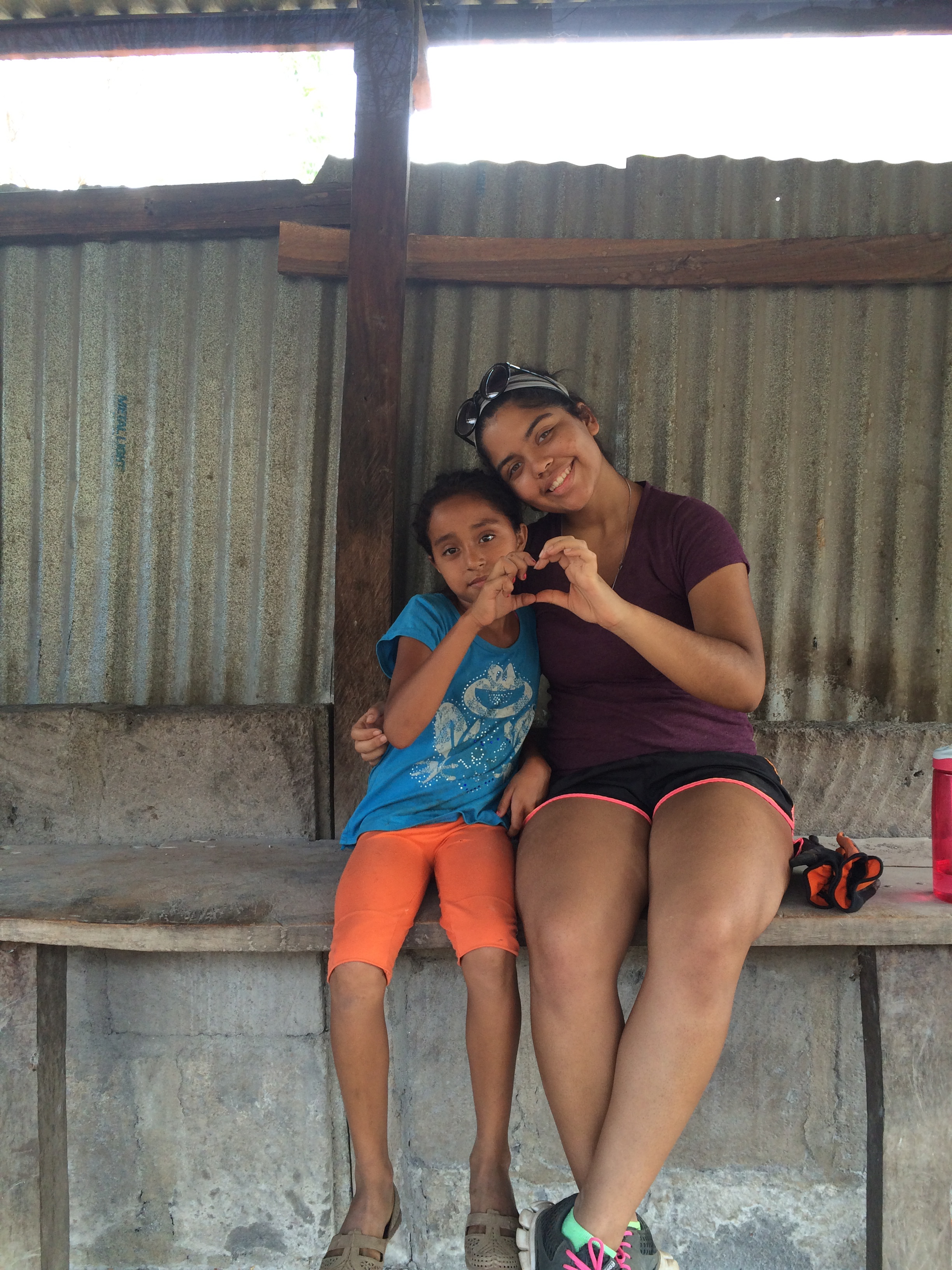Swampscott High School student Laura Gilberti bonds with a young child from Nicaragua during the school’s service trip in April.
By MEAGHAN CASEY
While some teens dream of sun, sand and relaxation for spring break, a dozen Swampscott High School students had other plans in mind.
In April, the students traveled to the village of Cañada Grande in Nicaragua with a goal of building a “lavadero,” or washing site, with a roof for shade, for its residents.
For five days, from 8 a.m. to 4 p.m., they toiled, battling heat blisters, sore muscles and fatigue. At the end of each day, they would return to the larger town of Terrabona to eat and sleep. Often, they would find time to gather in the park with local children to play soccer.
“That was the fun part,” said sophomore Chloe Smith. “Coming home after a long day of work, all the children would be waiting for us, so excited.”
“It was a good opportunity to gain perspective – not just that, but perspective to an extreme,” she continued. “It was better than I even expected.”

It was an awesome, life-changing experience for the kids,” said Jessica Diaz, the school’s world language content leader. “They were exposed to a different culture — seeing how people around the world live and practicing their Spanish, all while helping a community in need. The biggest impact, I think, was for them to realize how much one person can make a difference.”

Diaz and ELL teacher Stephanie DeOrio, a 2006 graduate of Swampscott High, paired up to travel with the students.
“It was amazing,” said DeOrio. “I’m so proud of how hard all the students worked.They pushed me to keep going.”
To organize the trip, Diaz worked with El Porvenir, an organization dedicated to improving the standard of living of rural Nicaraguans through clean water, sanitation, health education and watershed management projects.This is the second trip Swampscott students have taken in conjunction with El Porvenir. During the first trip in 2014, the group visited the community of El Sauce and the small village of Los Panales.
Joe Varghese, a sophomore, followed in the footsteps of his older sister, who had taken the trip in 2014. He also had experience taking a service trip to Haiti in 2015 with a group from his church.
“That inspired me to do more to help people in my life,” said Varghese. “This trip, for me, was really a learning experience. Every place is so different and you gain more knowledge everywhere you go.”
In Cañada Grande, which is a very rural community, the average family income is $45 and homes are constructed with a combination of adobe, brick, straw and cardboard. The lavadero the students built was positioned in a central location,close to the town well. It’s equipped with two stalls for bathing, as well as wash stations.
“It’s so essential,” said Diaz. “Without it, you have women and children in the village spending hours lugging water back and forth, and you have women standing in dirty water washing clothes. That’s how infections spread. When we left, we knew at least the women of that community would benefit from the work we did.”
“It was difficult work, but cool to see you were producing something and helping someone besides yourself,” said sophomore Joshua Badal-Rodrigues.
For sophomore Jack Leahy, who has experience in the family business, Leahy Landscaping, the manual labor was eye-opening.
“I’ve done work for my dad on job sites, but this was so different,” he said. “Here, we’re so used to just driving to the store and having everything ready, but there it’s walking up hills to get the materials and bring them back and then sifting everything yourself.”
At the completion of the project, the students celebrated with a piñata party in the village on Friday night and enjoyed free time on Saturday and Sunday swimming in a lake, visiting a local market and zip-lining through a rainforest.
In addition to their work on the lavadero, the students also left their imprint on thecommunity at large.In the monthsleading up to thetrip, the students had raised funds for seedlings and trees for reforestation in the community. They also organized a school-wide collection for soccer balls and other sports equipment to donate to four local elementary schools.
Although the service component was the main purpose of the trip, Diaz said the language learning was an added benefit. By immersing themselves with the local residents, the students became much more comfortable with conversational Spanish. Two students even came back and, after putting in extra time and work over the summer, skipped a level of Spanish this year. One student, senior Laura Gilberti, is in Spanish III this year after starting in Spanish I last year. A native of Brazil, Gilberti also speaks Portuguese and has an interest in Spanish-speaking countries.
“I completely fell in love with Nicaragua—especially helping the community and playing with the children,” said Gilberti. “It was definitely a defining moment. There’s a good chance I pursue a career that would involve working with children, and I’ve even thought about going into the Peace Corps.”
The students unanimously agreed that while they may have gone on the journey with the idea of changing the lives of others, the result was reciprocal. They returned with fuller hearts, stronger friendships and a more defined sense of purpose and appreciation for life. Sometimes the lines between giving and receiving are just that blurred, and we can all be a little thankful for that.
Photos: Courtesy of Jessica Diaz

